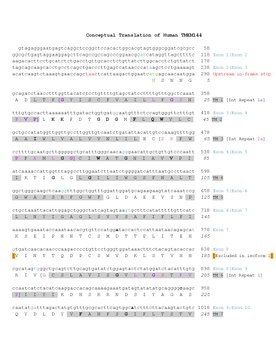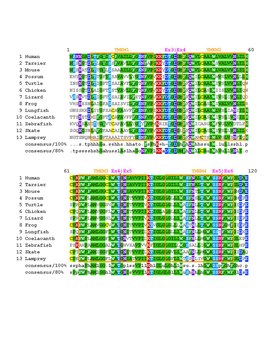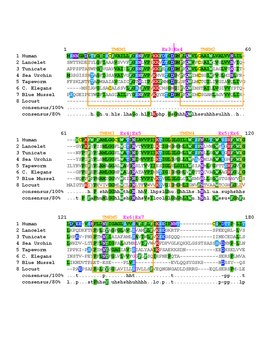Biology:TMEM144

Transmembrane Protein 144 (TMEM144) is a protein in humans encoded by the TMEM144 gene.[1]
Gene
Transmembrane Protein 144 is located on the plus strand of chromosome 4 (4q32.1), spanning a total of 40,857 base pairs.[2] The TMEM144 gene transcribes a mRNA sequence 3,210 nucleotides in length and composed of 13 exons.[3]
Protein
There exist two isoforms of human Transmembrane Protein 144.[3] Isoform one consist of 345 amino acids with a total mass of 37.6 kDa.[1][4] This isoform has a theoretical isoelectric point of 6.63.[5] The second isoform is 169 amino acids long with a mass of 18.3 kDa.[3]
Expression
TMEM144 is over-expressed in adult brain tissue with low regional specificity.[6][7] TMEM144 appears enriched in oligodendrocytes[8][7] and immune cells, such as dendritic cells and monocytes.[9][7]
Cellular Localization
Precise cell localization has multiple predicted locations. Localization tools state TMEM144 is likely found in the plasma membrane, endoplasmic reticulum,[10] Lysosome/Vacuole, or Golgi apparatus.[11] However, an immunofluorescent staining of various human cell lines display localization to the mitochondria.[7]
Post Translational Modifications
There exists five predicted post translational modifications for TMEM144, including four sites of phosphorylation[12] and a sumoylation site.[13]
Interacting Proteins
Several proteins have been observed to be physically associated with TMEM144, including Transmembrane Protein 237, Homocysteine-Responsive Endoplasmic Reticulum-Resident Ubiquitin-Like Domain Member 2 Protein, Translocase of Inner Mitochondrial Membrane Domain-Containing Protein 1, Free Fatty Acid Receptor 2, Aquaporin 6, Serine Rich Single-Pass Membrane Protein 1, and Adrenoceptor Beta 2.[14][15]
Homology
Transmembrane Protein 144 arose approximately 694 million years ago in desert locust.[16] It can be found in both vertebrates and invertebrates.[16][17] It takes TMEM144 approximately 6.8 million years to make a 1% change to its amino acid sequence, indicating a moderately low rate of evolution.


Ortholog Table
| Genus and Species | Common Name | Taxonomic Class | Median Date of Divergence (MYA) | Accession # | Sequence Length (aa) | Sequence Identity (%) | Sequence Similarity (%) |
| Homo Sapiens | Human | Mammalia | 0 | NP_060812.2 | 345 | 100.0 | 100.0 |
| Carlito syrichta | Philippine tarsier | Mammalia | 69 | XP_012639059.1 | 345 | 94.2 | 97.4 |
| Mus musculus | House mouse | Mammalia | 87 | NP_001366471.1 | 348 | 85.9 | 92.2 |
| Trichosurus vulpecula | Brushtail possum | Mammalia | 160 | XP_036620586.1 | 349 | 77.7 | 90.3 |
| Chelydra serpentina | Snapping turtle | Reptilia | 319 | KAG6931534.1 | 358 | 67.0 | 84.1 |
| Gallus gallus | Red junglefowl | Aves | 319 | XP_420383.2 | 357 | 66.9 | 82.6 |
| Zootoca vivipara | Viviparous lizard | Reptilia | 319 | XP_034969125.1 | 360 | 65.9 | 82.3 |
| Rana temporaria | Common frog | Amphibia | 353 | XP_040188243.1 | 358 | 64.2 | 81.0 |
| Protopterus annectens | West African lungfish | Dipnoi | 408 | XP_043918387.1 | 407 | 56.4 | 69.6 |
| Latimeria chalumnae | African coelacanth | Coelacanthi | 414 | XP_014346971.1 | 407 | 56.0 | 71.6 |
| Danio rerio | Zebrafish | Actinopterygii | 431 | NP_001005983.1 | 380 | 50.0 | 64.8 |
| Amblyraja radiata | Thorny skate | Chondrichthyes | 464 | XP_032874310.1 | 486 | 45.7 | 58.4 |
| Branchiostoma lanceolatum | European lancelet | Leptocardii | 556 | CAH1267272.1 | 402 | 44.1 | 58.8 |
| Petromyzon marinus | Sea lamprey | Hyperoartia | 599 | XP_032811478.1 | 396 | 50.1 | 64.9 |
| Ciona intestinalis | Vase tunicate | Ascidiacea | 603 | XP_026696612.1 | 395 | 46.6 | 59.2 |
| Strongylocentrotus purpuratus | Purple sea urchin | Echinoidea | 619 | XP_030836295.1 | 363 | 46.8 | 64.7 |
| Echinococcus multilocularis | Cyclophyllid tapeworm | Cestoda | 694 | CDS37915.1 | 351 | 41.0 | 59.8 |
| Caenorhabditis elegans | Roundworm | Chromadorea | 694 | NP_498062.2 | 345 | 38.7 | 56.0 |
| Mytilus edulis | Blue mussel | Bivalvia | 694 | CAG2251154.1 | 385 | 36.0 | 52.0 |
| Schistocerca gregaria | Desert locust | Insecta | 694 | XP_049849104.1 | 278 | 25.6 | 44.1 |
Clinical Significance
Transmembrane Protein 144 is predicted to be a direct or indirect negative regulator of kisspeptin.[18] High expression of TMEM144 is prognostically favorable for patient with endometrial cancer.[19][7] Whereas in patients with pancreatic cancer, high expression of TMEM144 is associated with poor prognostic outcomes.[19][7]
References
- ↑ 1.0 1.1 NCBI Gene (National Center for Biotechnology Information Gene Database) entry on TMEM144 <https://www.ncbi.nlm.nih.gov/gene/55314>.
- ↑ NCBI Nucleotide (National Center for Biotechnology Information Nucleotide Database) entry on TMEM144 <https://www.ncbi.nlm.nih.gov/nuccore/NM_018342.5>.
- ↑ 3.0 3.1 3.2 UniProt entry of TMEM144 <https://www.uniprot.org/uniprotkb/Q7Z5S9/entry#sequences>.
- ↑ NCBI Protein (National Center for Biotechnology Information Protein Database) entry on TMEM144 <https://www.ncbi.nlm.nih.gov/protein/NP_060812.2>.
- ↑ ExPASy Compute pI/Mw tool entry on TMEM144 protein <https://web.expasy.org/compute_pi/>.
- ↑ Sjöstedt E et al., An atlas of the protein-coding genes in the human, pig, and mouse brain. Science. (2020) PubMed: 32139519 DOI: 10.1126/science.aay5947
- ↑ 7.0 7.1 7.2 7.3 7.4 7.5 TMEM144 entry on the Human Protein Atlas <https://www.proteinatlas.org/ENSG00000164124-TMEM144>.
- ↑ Karlsson M et al., A single-cell type transcriptomics map of human tissues. Sci Adv. (2021) PubMed: 34321199 DOI: 10.1126/sciadv.abh2169
- ↑ Monaco, Gianni et al. “RNA-Seq Signatures Normalized by mRNA Abundance Allow Absolute Deconvolution of Human Immune Cell Types.” Cell reports vol. 26,6 (2019): 1627-1640.e7. doi:10.1016/j.celrep.2019.01.041
- ↑ PSORT II entry on human TMEM144 protein <https://psort.hgc.jp/cgi-bin/runpsort.pl>.
- ↑ DeepLoc entry of human TMEM144 protein for cell localization prediction <https://services.healthtech.dtu.dk/service.php?DeepLoc-2.0>.
- ↑ NetPhos 3.1 entry on human TMEM144 <https://services.healthtech.dtu.dk/service.php?NetPhos-3.1>.
- ↑ GPS SUMO entry on human TMEM144 <http://sumosp.biocuckoo.org/showResult.php>.
- ↑ Luck, K., Kim, DK., Lambourne, L. et al. A reference map of the human binary protein interactome. Nature 580, 402–408 (2020). https://doi.org/10.1038/s41586-020-2188-x
- ↑ TMEM144 entry on IntAct <https://www.ebi.ac.uk/intact/search?query=tmem144>
- ↑ 16.0 16.1 NCBI BLAST Protein entry on Homo sapiens TMEM144 (NP_060812.2) to identify various orthologs <https://blast.ncbi.nlm.nih.gov/Blast.cgi?PAGE=Proteins>.
- ↑ TimeTree of Life entry of Homo sapiens compared to ortholog species in Table 1 <http://www.timetree.org/>.
- ↑ Prentice, L. M., d'Anglemont de Tassigny, X., McKinney, S., Ruiz de Algara, T., Yap, D., Turashvili, G., Poon, S., Sutcliffe, M., Allard, P., Burleigh, A., Fee, J., Huntsman, D. G., Colledge, W. H., & Aparicio, S. A. J. (2011). The testosterone-dependent and independent transcriptional networks in the hypothalamus of GPR54 and Kiss1 knockout male mice are not fully equivalent. BMC Genomics, 12(1). https://doi.org/10.1186/1471-2164-12-209
- ↑ 19.0 19.1 Uhlen M et al., A pathology atlas of the human cancer transcriptome. Science. (2017) PubMed: 28818916 DOI: 10.1126/science.aan2507
 |



